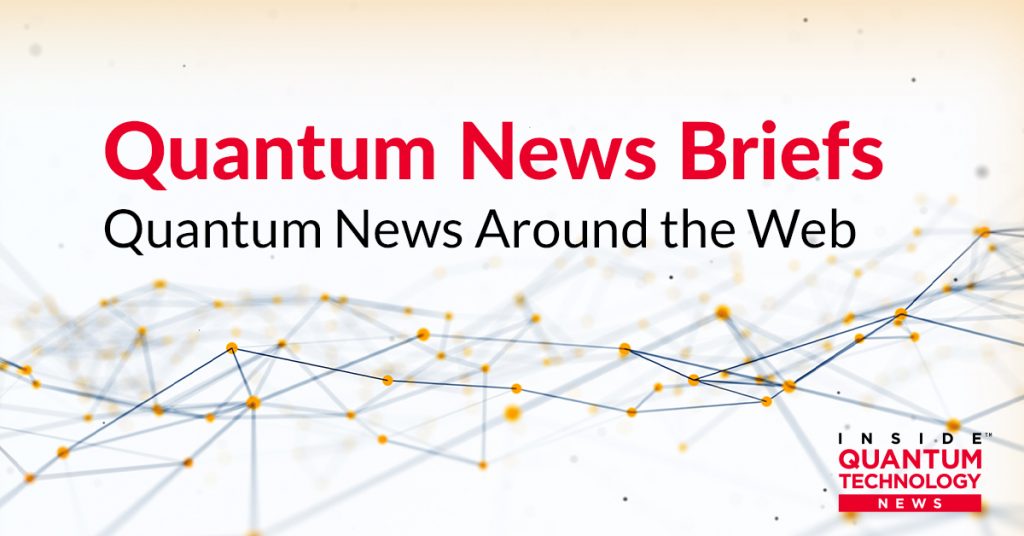Quantum News Briefs opens today with IBM’s “Quantum Serverless” approach which is enabled by Qiskit followed IBM’s “Quantum Serverless” approach followed by summary of a Blackberry blog describing how the company working working to proactively protect against quantum-enabled codebreakers. Next, Trumpf prepares for mission liftoff in 2027 with first satellite controlled by quantum sensing technology and MORE
*****
IBM paving on-rap to quantum with “Serverless” approach
IBM is helping to pave an on-ramp to quantum through layers of abstraction, much as cloud service providers are increasingly promoting “serverless” computing. Karl Freund reports on “quantum serverless” in Forbes and Quantum News Briefs summarizes below.
IBM calls this approach “Quantum Serverless”, and intends to enable users to take advantage of quantum resources at scale without having to worry about the intricacies of the underlying hardware. This frictionless development process is enabled in part by the open-source Qiskit, which is a containerized execution environment for classical code that has low-latency access to quantum hardware. This enables a wide variety of workloads that make iterative or repeated use of quantum hardware to execute dramatically faster than was previously possible. In fact, with Qiskit Runtime IBM was able to demonstrate a 120x speed-up on a variational quantum Eigensolver algorithm compared to the previous circuit API model.
The name “serverless” could a bit confusing. Of course there are servers (traditional and quantum) being used, but the developer focuses only on coding, with no need for consideration of the hardware infrastructure. Everything is encapsulated as cloud services and the service requires no capacity or life cycle management considerations and scales seamlessly. Finally, the user only pays for consumption, never for idle time.
Going forward, IBM is rethinking the way that quantum programs run, exploring even more complex quantum computations and hopefully realizing and accelerating the realization of true quantum advantage, the point that quantum is substantially superior to conventional computation resource. IBM has shown a proof of concept for Quantum Serverless,
*****
Blackberry engineers already working to proactively protect against quantum-enabled codebreakers
Sussman explains that “Organizations, including those in the cybersecurity and internet of things (IoT) space, are now forming new strategic partnerships to prepare for post-quantum security”. This step is crucial for things with long lifecycles, such as systems in critical infrastructure, industrial controls, aerospace and military electronics, telecommunications, transportation infrastructure, and connected cars.
BlackBerry, through its Cylance® AI-based cybersecurity portfolio and its deep roots in the IoT and automotive space via its QNX® real-time operating system, is uniquely positioned in the marketplace, effectively straddling the two technology sectors most likely to be affected by the leap to quantum computing. As a result, it stands to reason that BlackBerry engineers are already working to provide solutions that will proactively protect against tomorrow’s quantum-enabled codebreakers. With its QNX technology embedded in more than 215 million cars on the road today, BlackBerry recently announced it would provide support for quantum-resistant secure boot signatures for NXP® Semiconductors’ vehicle networking processors. The companies will work together and use the BlackBerry® Certicom® Code Signing and Key Management Server to illustrate how to mitigate the risk of potential quantum computing attacks on in-vehicle software and long-lifecycle assets.
The integration will allow software to be digitally signed using the NIST-endorsed CRYSTALS Dilithium digital signature scheme that will be quantum resistant, providing peace of mind for when quantum-powered capabilities eventually threaten traditional code-signing schemes.
Sussman also discusses government preparation for post-quantum security. Click here to read entire blog.
*****
Trumpf prepares VCSELs for space mission lift off in 2027 with first satellite controlled by quantum sensing technology
In 2027, the satellite with the quantum-based gyroscope is scheduled to launch into space to generate highly precise attitude determination.The core component of the sensor will be a VCSEL light source. As miniaturization and robustness are essential for the application, the very small and durable VCSELs are suitable for this purpose. Compared to existing laser solutions, VCSELs can be designed that are several orders of magnitude smaller and at significantly lower cost.
Quantum technology can ensure long-term measurement stability, provide high performance in a small space, and reduce weight, says Trumpf. This not only allows satellites to hold their position precisely for years, but also supports other spectroscopic applications and atomic clocks. The company is developing a single-mode VCSEL with an 10mW output at at 795 nm. This is ten times higher than the laser power this technology was able to offer previously. The VCSEL also delivers the required stability over a wide range of temperatures and robustness demanded by space usage.
The proposed single-mode VCSEL will feature stable polarization and a narrow bandwidth to address the high precision needed in the quantum sensor.
*****
Free quantum computing class for tech leaders launched by Linux Foundation & World Bank
As Sheila Jagannathan, head of the World Bank’s Open Learning Campus, explained. “Given its potential impact, it is important to develop foundational knowledge of this new technology as it develops, to understand its implications for our skills, systems, and technological governance.” Exactly so.
This is not a deep course. It only takes about three hours to complete. But with it, you can pick up the fundamentals of quantum computing and gain a better understanding of and how it will disrupt today’s technology. It covers where we are today with quantum computing and what we can expect from it tomorrow. It also dispels some of quantum computing’s myths.
*****
Sandra K. Helsel, Ph.D. has been researching and reporting on frontier technologies since 1990. She has her Ph.D. from the University of Arizona.
